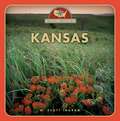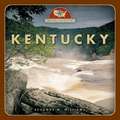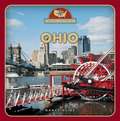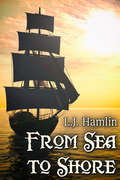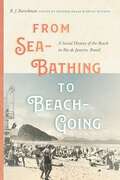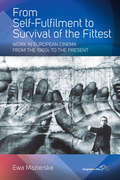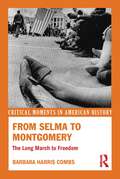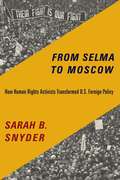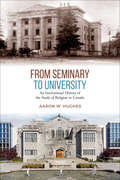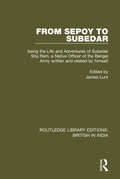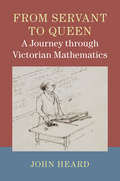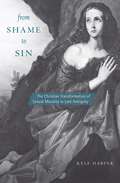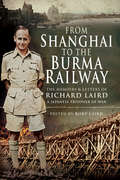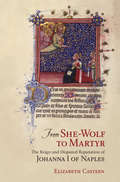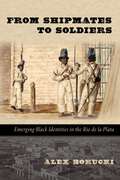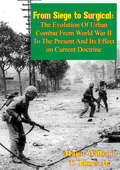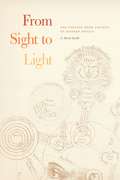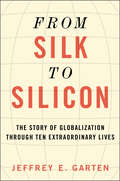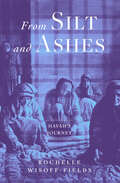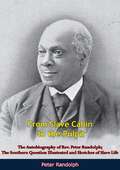- Table View
- List View
From Sea to Shining Sea: Kansas
by W. Scott IngramRevised volume features new text, new sidebars, plus a time line and almanac of fast facts, and a gallery of famous people from Kansas.
From Sea to Shining Sea: Kentucky
by Suzanne M. WilliamsDescribes the geography, plants and animals, history, economy, language, culture and people of the state of Kentucky.
From Sea to Shining Sea: Nebraska
by Myra S. WeatherlyRevised volume features new text, new sidebars, plus a time line and almanac of fast facts, and a gallery of famous people from Nebraska.
From Sea to Shining Sea: Nevada
by Suzanne M. WilliamsRevised volume features new text, new sidebars, new photographs, new (and more) maps, plus a time line and almanac of fast facts, and a gallery of famous people from the state.
From Sea to Shining Sea: Ohio
by Nancy KlineFrom Sea to Shining Sea, Second Series puts you on the right track. Each title is your ticket for a tour of one of the states or territories of the United States.
From Sea to Shining Sea: The Story of America Volume 5
by Christopher Zehnder Catholic Schools Textbook Project StaffTraces the history of the United States, with emphasis on the contributions of the Catholic Church and its followers, from the discovery of the continent by Saint Brendan and later, the Vikings, to the beginning of the twentieth century.
From Sea to Shore
by L. J. HamlinThese two historical gay pirate stories by prolific author L.J. Hamlin are sure to shiver yer timbers!Two Men on a Dead Man's Chest -- Harry has about had it with Thomas, the newest member of the crew. Unfortunately for them, the crew has decided the best way for them to work out their differences is to maroon them for seven days, chained together the whole time.My Pirate Love -- Abraham loves the sea more than anything, but he can't resist the pull of his alluring lover Dale, either, eagerly awaiting each time they reunite.
From Sea-Bathing to Beach-Going: A Social History of the Beach in Rio de Janeiro, Brazil (Diálogos Series)
by B.J. Barickman2023 Honorable Mention, Warren Dean Prize in Brazilian HistoryIn From Sea-Bathing to Beach-Going B. J. Barickman explores how a narrow ocean beachfront neighborhood and the distinctive practice of beach-going invented by its residents in the early twentieth century came to symbolize a city and a nation. Nineteenth-century Cariocas (residents of Rio) ostensibly practiced sea-bathing for its therapeutic benefits, but the bathing platforms near the city center and the rocky bay shore of Flamengo also provided places to see and be seen. Sea-bathing gave way to beach-going and sun-tanning in the new beachfront neighborhood of Copacabana in the 1920s. This study reveals the social and cultural implications of this transformation and highlights the distinctive changes to urban living that took place in the Brazilian capital. Deeply informed by scholarship about race, class, and gender, as well as civilization and modernity, space, the body, and the role of the state in shaping urban development, this work provides a major contribution to the social and cultural history of Rio de Janeiro and to the history of leisure.
From Self-fulfilment to Survival of the Fittest: Work in European Cinema from the 1960s to the Present
by Ewa MazierskaContrary to the assumption that Western and Eastern European economies and cinemas were very different from each other, they actually had much in common. After the Second World War both the East and the West adopted a mixed system, containing elements of both socialism and capitalism, and from the 1980s on the whole of Europe, albeit at an uneven speed, followed the neoliberal agenda. This book examines how the economic systems of the East and West impacted labor by focusing on the representation of work in European cinema. Using a Marxist perspective, it compares the situation of workers in Western and Eastern Europe as represented in both auteurist and popular films, including those of Tony Richardson, Lindsay Anderson, Jean-Luc Godard, Andrzej Wajda, DušanMakavejev, Jerzy Skolimowski, the Dardenne Brothers, Ulrich Seidl and many others.
From Selma to Montgomery: The Long March to Freedom (Critical Moments in American History)
by Barbara Harris CombsOn March 7, 1965, a peaceful voting rights demonstration in Selma, Alabama, was met with an unprovoked attack of shocking violence that riveted the attention of the nation. In the days and weeks following "Bloody Sunday," the demonstrators would not be deterred, and thousands of others joined their cause, culminating in the successful march from Selma to Montgomery. The protest marches led directly to the passage of the Voting Rights Act of 1965, a major piece of legislation, which, ninety-five years after the passage of the Fifteenth Amendment, made the practice of the right to vote available to all Americans, irrespective of race. From Selma to Montgomery chronicles the marches, placing them in the context of the long Civil Rights Movement, and considers the legacy of the Act, drawing parallels with contemporary issues of enfranchisement. In five concise chapters bolstered by primary documents including civil rights legislation, speeches, and news coverage, Combs introduces the Civil Rights Movement to undergraduates through the courageous actions of the freedom marchers.
From Selma to Moscow: How Human Rights Activists Transformed U.S. Foreign Policy
by Sarah B. SnyderThe 1960s marked a transformation of human rights activism in the United States. At a time of increased concern for the rights of their fellow citizens—civil and political rights, as well as the social and economic rights that Great Society programs sought to secure—many Americans saw inconsistencies between domestic and foreign policy and advocated for a new approach. The activism that arose from the upheavals of the 1960s fundamentally altered U.S. foreign policy—yet previous accounts have often overlooked its crucial role.In From Selma to Moscow, Sarah B. Snyder traces the influence of human rights activists and advances a new interpretation of U.S. foreign policy in the “long 1960s.” She shows how transnational connections and social movements spurred American activism that achieved legislation that curbed military and economic assistance to repressive governments, created institutions to monitor human rights around the world, and enshrined human rights in U.S. foreign policy making for years to come. Snyder analyzes how Americans responded to repression in the Soviet Union, racial discrimination in Southern Rhodesia, authoritarianism in South Korea, and coups in Greece and Chile. By highlighting the importance of nonstate and lower-level actors, Snyder shows how this activism established the networks and tactics critical to the institutionalization of human rights. A major work of international and transnational history, From Selma to Moscow reshapes our understanding of the role of human rights activism in transforming U.S. foreign policy in the 1960s and 1970s and highlights timely lessons for those seeking to promote a policy agenda resisted by the White House.
From Seminary to University: An Institutional History of the Study of Religion in Canada
by Aaron HughesThis book provides the first historical examination of the study of religion in Canada. While secular departments of religious studies would not emerge in Canada until the late 1960s, the teaching of religion under the guise of divinity, theology, the Bible, and moral philosophy has been omnipresent for much of the country’s history. The gradual transformation from the teaching of religious truths at denominational theological colleges to the non-denominational and secular study of religion at universities was a lengthy and complicated one. From Seminary to University examines this transformation against a much broader backdrop. It is not simply the history of individual departments scattered across the nation. Instead, the story reveals the many non-academic forces that made those departments possible, such as the creation of the United Church of Canada, the adoption of multiculturalism, and the introduction of the Charter of Rights and Freedoms. In recounting this transformation, From Seminary to University illuminates an important part of Canadian history.
From Sepoy to Subedar: Being the Life and Adventures of Subedar Sita Ram, a Native Officer of the Bengal Army, Written and Related by Himself (Routledge Library Editions: British in India #9)
by James LuntBritish military history in India has been amply documented, but From Sepoy to Subedar by Sita Ram is the only published account by an Indian soldier of his experiences serving in the East India Company’s Army. These memoirs cover a span of more than forty years of active service, and provide a fascinating insight into the lives of the Indian soldiers serving under the British.
From Servant to Queen: A Journey through Victorian Mathematics
by John HeardWith a few notable exceptions, pure mathematics in Britain at the beginning of the nineteenth century was mainly a recreation for amateurs. Drawing on primary sources, John Heard provides an engaging account of the process by which it rose to become an academic discipline of repute which by the First World War was led by G. H. Hardy, and supported by the internationally-respected London Mathematical Society. In chronicling that rise, this book describes key contributions and the social environment in which mathematicians operated, using contemporary commentary where appropriate. No mathematical knowledge is required, and readers with a wide range of interests and backgrounds will find much to enjoy here. The material is presented from an impartial point of view, and provides full references to help any researchers who want to dig deeper into the original sources. The result is a unique insight into the world of Victorian mathematics and science.
From Shame to Sin
by Kyle HarperWhen Rome was at its height, an emperor’s male beloved, victim of an untimely death, would be worshipped around the empire as a god. In this same society, the routine sexual exploitation of poor and enslaved women was abetted by public institutions. Four centuries later, a Roman emperor commanded the mutilation of men caught in same-sex affairs, even as he affirmed the moral dignity of women without any civic claim to honor. The gradual transformation of the Roman world from polytheistic to Christian marks one of the most sweeping ideological changes of premodern history. At the center of it all was sex. Exploring sources in literature, philosophy, and art, Kyle Harper examines the rise of Christianity as a turning point in the history of sexuality and helps us see how the roots of modern sexuality are grounded in an ancient religious revolution. While Roman sexual culture was frankly and freely erotic, it was not completely unmoored from constraint. Offending against sexual morality was cause for shame, experienced through social condemnation. The rise of Christianity fundamentally changed the ethics of sexual behavior. In matters of morality, divine judgment transcended that of mere mortals, and shame-a social concept-gave way to the theological notion of sin. This transformed understanding led to Christianity’s explicit prohibitions of homosexuality, extramarital love, and prostitution. Most profound, however, was the emergence of the idea of free will in Christian dogma, which made all human action, including sexual behavior, accountable to the spiritual, not the physical, world.
From Shanghai to the Burma Railway: The Memoirs & Letters of Richard Laird, A Japanese Prisoner of War
by Rory LairdA graphic record of one man’s experience in an infamous POW camp during World War II, and how he survived being forced to build the “Death Railway.”Captured after fighting in the Malayan Campaign, Richard Laird was incarcerated in Changi before being drafted as slave labor with “F” Force on the notorious Burma Railway. He was one of only 400 out of 1600 to survive Songkurai No. 2 Camp, despite disease and terrible hardship. His moving memoir begins with a rare description of ex-patriate life in 1930s Shanghai with the Sino-Japanese war raging around the European cantonments. An additional dimension to his story is the developing relationship between the author and Bobbie Coupar Patrick to whom he became engaged shortly before the fall of Singapore. Bobbie’s letters graphically described her dramatic escape to Australia and work for Force 136. They were reunited in Colombo, Ceylon and their son has been instrumental in compiling this exceptional record. Three appendices round off this superb book including the official report on the hardships and losses suffered by “F” Force.“A compelling story that deserves to be widely read.” —Firetrench
From She-Wolf to Martyr: The Reign and Disputed Reputation of Johanna I of Naples
by Elizabeth CasteenIn 1343 a seventeen-year-old girl named Johanna (1326–1382) ascended the Neapolitan throne, becoming the ruling monarch of one of medieval Europe's most important polities. For nearly forty years, she held her throne and the avid attention of her contemporaries. Their varied responses to her reign created a reputation that made Johanna the most notorious woman in Europe during her lifetime. In From She-Wolf to Martyr, Elizabeth Casteen examines Johanna's evolving, problematic reputation and uses it as a lens through which to analyze often-contradictory late-medieval conceptions of rulership, authority, and femininity. When Johanna inherited the Neapolitan throne from her grandfather, many questioned both her right to and her suitability for her throne. After the murder of her first husband, Johanna quickly became infamous as a she-wolf—a violent, predatory, sexually licentious woman. Yet, she also eventually gained fame as a wise, pious, and able queen. Contemporaries—including Francesco Petrarch, Giovanni Boccaccio, Birgitta of Sweden, and Catherine of Siena—were fascinated by Johanna. Drawing on a wide range of textual and visual sources, Casteen reconstructs the fourteenth-century conversation about Johanna and tracks the role she played in her time’s cultural imaginary. She argues that despite Johanna’s modern reputation for indolence and incompetence, she crafted a new model of female sovereignty that many of her contemporaries accepted and even lauded.
From Shipmates to Soldiers: Emerging Black Identities in the Río de la Plata (Diálogos Series)
by Alex BoruckiAlthough it never had a plantation-based economy, the Río de la Plata region, comprising present-day Argentina, Uruguay, and Paraguay, has a long but neglected history of slave trading and slavery. This book analyzes the lives of Africans and their descendants in Montevideo and Buenos Aires from the late colonial era to the first decades of independence. The author shows how the enslaved Africans created social identities based on their common experiences, ranging from surviving together the Atlantic and coastal forced passages on slave vessels to serving as soldiers in the independence-era black battalions. In addition to the slave trade and the military, their participation in black lay brotherhoods, African &“nations,&” and the lettered culture shaped their social identities. Linking specific regions of Africa to the Río de la Plata region, the author also explores the ties of the free black and enslaved populations to the larger society in which they found themselves.
From Siege to Surgical: The Evolution of Urban Combat from World War II to the Present and Its Effect on Current Doctrine
by Major William T. James Jr.This study investigates what effect the evolution of urban combat from World War II to the present has had on current urban combat doctrine. Urban combat operations have played a pivotal role in the conflicts of the twentieth century, and will continue to be a crucial part of future U.S. power projection operations. It is imperative that lessons learned from previous urban combat operations be studied for applicability to current urban combat doctrine.The study analyzes the urban battles of Aachen, Manila, Seoul, Hue, JUST CAUSE, and Mogadishu to identify salient lessons for conducting successful offensive urban combat operations; then reviews current U.S. Army urban combat doctrine. The study then evaluates current doctrine using identified salient lessons to determine their effect. The study finds that the primary impacts of previous urban combat operations on current doctrine are that doctrine now embraces the idea of varied conditions for urban combat and validates the concept of fighting as a combined arms team in a built-up area. The study further finds that FM 90-10, Military Operations on Urban Terrain is obsolete, and that key procurement decisions have left U.S. forces without critical weapons that have proven decisive in urban combat.
From Sight to Light: The Passage from Ancient to Modern Optics
by A. Mark SmithFrom its inception in Greek antiquity, the science of optics was aimed primarily at explaining sight and accounting for why things look as they do. By the end of the seventeenth century, however, the analytic focus of optics had shifted to light: its fundamental properties and such physical behaviors as reflection, refraction, and diffraction. This dramatic shift—which A. Mark Smith characterizes as the “Keplerian turn”—lies at the heart of this fascinating and pioneering study. Breaking from previous scholarship that sees Johannes Kepler as the culmination of a long-evolving optical tradition that traced back to Greek antiquity via the Muslim Middle Ages, Smith presents Kepler instead as marking a rupture with this tradition, arguing that his theory of retinal imaging, which was published in 1604, was instrumental in prompting the turn from sight to light. Kepler’s new theory of sight, Smith reveals, thus takes on true historical significance: by treating the eye as a mere light-focusing device rather than an image-producing instrument—as traditionally understood—Kepler’s account of retinal imaging helped spur the shift in analytic focus that eventually led to modern optics. A sweeping survey, From Sight to Light is poised to become the standard reference for historians of optics as well as those interested more broadly in the history of science, the history of art, and cultural and intellectual history.
From Silk to Silicon
by Jeffrey E. GartenThe story of globalization, the most powerful force in history, as told through the life and times of ten people who changed the world by their singular, spectacular accomplishments.This is the first book to look at the history of globalization through the lens of individuals who did something transformative, as opposed to describing globalization through trends, policies, or particular industries. From Silk to Silicon tells the story of who these men and women were, what they did, how they did it and how their achievements continue to shape our world today. They include:* Genghis Khan, who united east and west by conquest and by opening new trade routes built on groundbreaking transportation, communications, and management innovations.* Mayer Amschel Rothschild, who arose from an oppressive Jewish ghetto to establish the most powerful bank the world has seen, and ushered in an era of global finance.* Cyrus Field, who became the father of global communications by leading the effort to build the transatlantic telegraph, the forerunner to global radio, TV, and the worldwide Internet.* Margaret Thatcher, whose controversial policies opened the gusher of substantially free markets that linked economies across borders.* Andy Grove, a Hungarian refugee from the Nazis who built the company--Intel--that figured out how to manufacture complex computer chips on a mass, commercial scale and laid the foundation for Silicon Valley's computer revolution.Through these stories Jeffrey E. Garten finds the common links between these figure and probes critical questions including: How much influence can any one person have in fundamentally changing the world? And how have past trends in globalization affected the present and how will they shape the future? From Silk to Silicon is an essential book to understanding the past--and the future--of the most powerful force of our times.y did each leave? What do their stories tell us about globalization today? What do they imply for the future?With the Internet tying the world together in ways that would have been unfathomable just a few years ago, with the economic ups and downs of China and other emerging nations whipsawing international markets, and with terrorism causing the largest flows of refugees since the end of World War II, a fresh way of thinking about globalization could not be more urgent. That is exactly what From Silk to Silicon provides.Praise for From Silk to Silicon"This is a tale of globalization and leadership that is both sweeping and personal. By focusing on ten transformational people, it shows how individuals can affect the flow of history. It's a guide to the future as well as to the past."--Walter Isaacson, author of Steve Jobs, Einstein, and Benjamin Franklin"From Silk to Silicon creatively combines the impersonal forces of globalization with the very personal faces of biography in an engaging and thought-provoking story. Ranging over eight centuries of empires, exploration, and enterprise, Garten's colorful histories portray how willpower and persistence can propel societies to new achievements--and he says the best is yet to come!"--Robert B. Zoellick, former president of the World Bank"Impressive, fascinating, and very creative. Jeffrey Garten draws on decades of experience in the modern world economy to tell the story of globalization and, in so doing, not only brings the creation of our present world into focus but also widens our understanding of how the world may well evolve in the future."--Daniel Yergin, Pulitzer Prize-winning author of The Prize"Jeffrey Garten has brilliantly updated Thomas Carlyle's Great Man theory of history in his gallery of transformative figures, notably including a woman, who have spurred globalization. A tour de force--imaginative, informative, and just plain fun to read."--Strobe Talbott, president of the Brookings Institution"From Silk to Silicon is a most nifty work, as well as being serious history. Garten persuasively shows how, in the broad unfolding of events that brought us from the Dark Ages to the twenty-first century, ind...
From Silk to Silicon: The Story of Globalization Through Ten Extraordinary Lives
by Jeffrey E. GartenStories of ten historical figures who helped build the long road to globalization, from Genghis Khan to an Intel CEO: “Filled with brilliant vignettes.” —The Washington PostThis is the story of globalization, the most powerful force in history, as told through the lives and times of ten people who established new connections between people and nations—whether that was their primary goal or not. Rather than focusing on trends, policies, or particular industries, From Silk to Silicon views the topic of globalization for the first time through the lens of individuals and their transformative actions. It tells us who these men and women were, what they did, how they did it, and how their achievements continue to shape our world today. You’ll read about Genghis Khan, who united east and west by conquest and by opening new trade routes built on groundbreaking transportation, communications, and management innovations; Mayer Amschel Rothschild, who escaped the ghetto and ushered in an era of global finance; Cyrus Field, who led the effort to build the transatlantic telegraph; Margaret Thatcher, whose controversial policies opened the gusher of substantially free markets that linked economies across borders; Andy Grove, a Hungarian Holocaust survivor who, at Intel, laid the foundation for Silicon Valley’s computer revolution; and more.Economist Jeffrey E. Garten finds the common links between these figures and probes critical questions including: How much influence can any one person have in fundamentally changing the world? How have past trends in globalization affected the present? And how will they shape the future? “Fascinating and illuminating.” —Fareed Zakaria, author of Age of Revolutions“Garten has brilliantly updated Thomas Carlyle’s Great Man theory of history . . . A tour de force, imaginative, informative and just plain fun to read.” —Strobe Talbott, former Deputy Secretary of State“A terrific book on globalization . . . really compelling.” —Thomas L. Friedman, author of The World is Flat
From Silt and Ashes (Havah's Journey)
by Rochelle Wisoff-FieldsThe author of Please Say Kaddish for Me continues the story of a Jewish woman&’s journey from Czarist Russia to the heartland of America. Since losing her family in a pogrom, Havah Gitterman has already seen the worst of humanity. But at last, she and her husband Arel have made it to Kansas City, thanks to Havah&’s benefactor. Though haunted by friends and family they have lost—and those left behind—the couple hopes to make a new beginning, especially since Havah is pregnant. But some traditions are hard to change. Havah studies the Torah in Hebrew and considers teaching it to other girls, much to the chagrin of those still clinging to the old ways. And when Havah gives birth to a daughter who is blind, Arel&’s dismay shocks Havah, threatening their marriage. Havah will learn that even in the New World, prejudice and hate thrive in the shadows, and some wounds will never heal. But with perseverance and faith, Havah will find her way and set an example for her daughter, her community, and generations to come . . . &“Heart-wrenching, incisive and elegantly written, From Silt and Ashes is ultimately a compelling and riveting look into the heart of humanity—at is worst and its best.&” —Lisa Regan, author of Local Girl Missing &“Introduces the reader to unique and intensely-drawn characters who bring the story of Jewish persecution in Czarist Russia into stark realization.&” —Ginny Fite, author of Possession and Cromwell&’s Folly &“An engrossing family saga.&” —Jack Martin, author of Brother, Can You Spare a Dime? and Hail, Columbia!
From Slave Cabin to the Pulpit: The Autobiography of Rev. Peter Randolph (Regenerations Ser.)
by Peter RandolphPeter Randolph was born c. 1825 in Prince George County, Virginia, on the Brandon Plantation. He was enslaved upon birth and owned by Carter H. Edloe, who also held his mother and four or five siblings in bondage. Randolph's father was enslaved on a nearby plantation, and died when Randolph was approximately ten. Edloe had written a will directing that upon his death his slaves be freed and land he owned be sold, in part to pay his debts, but also to finance sending his former slaves to whichever state or colony they sought. Edloe's wishes were initially ignored by the executor of his will after he died in 1844. However, Randolph, who was Edloe's only literate slave, read the will and began legal proceedings to fight for his freedom and that of Edloe's other slaves. Three years later, they were freed by the order of a judge.Aided in settling by the Massachusetts Anti-Slavery Society, Randolph initially lived in Beacon Hill, Boston, where he attended the Belknap Street Church, led by Leonard Grimes. He was an original member of the Twelfth Baptist Church upon its formation and was later a preacher there...By 1861 Randolph was working at a newspaper in Boston and preaching. Randolph grew to become a vocal anti-slavery advocate as a member of the Massachusetts Anti-Slavery Society, donating money and otherwise aiding enslaved people seeking freedom. He published an account of his experience with slavery, The Sketch of a Slave life, or, an illustration of the peculiar institution, in 1855, with the goal of showing "that slaves, when liberated, can take care of themselves, and need no master or overseer to drive them to their toil." Randolph died on August 7, 1897, in Boston.-Wiki.
From Slave Ship to Freedom Road
by Julius Lester"From Slave Ship to Freedom Road" presents the story of slavery from its beginnings on the infamous ships of the Middle Passage to the enslaved Africans and their descendants.
